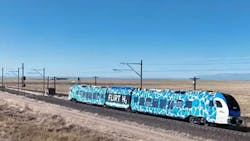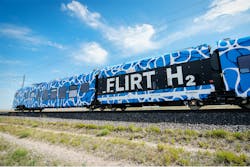Hydrogen Vehicle Testing at Transportation Technology Center
Reducing greenhouse gas emissions in transportation remains a critical challenge, as the sector accounted for approximately 29 percent of total U.S. emissions in 2022, according to the U.S. Environmental Protection Agency. While rail is already the smallest contributor within the transportation sector, responsible for just two percent of transportation emissions, there is still a strong commitment to further improving its environmental impact.
Despite the transportation industry's heavy reliance on petroleum fuels, ongoing advancements are being made to reduce emissions even further. To address this issue, the U.S. government has updated its climate goals to reduce greenhouse gas emissions by 50 to 52 percent below 2005 levels by 2030, with a vision for a net-zero economy by 2050.
Among the potential solutions, hydrogen fuel stands out, particularly for rail transportation. The U.S. National Blueprint for Transportation Decarbonization, released in January 2023 by key federal agencies, emphasizes hydrogen’s strategic role, noting that it is well-suited for applications requiring long driving ranges, rapid fueling and the ability to handle large or heavy payloads.
This article will explore the advancements in hydrogen vehicle testing at the Transportation Technology Center (TTC), including the implementation of a fully operational hydrogen fueling capability and its impact on rail and other surface transportation modes.
Hydrogen: A clean and powerful alternative
Hydrogen is a vital alternative fuel for reducing emissions, particularly when used in fuel cells, which generate electricity without combustion. Vehicles powered by hydrogen fuel cells produce no greenhouse gas emissions. When hydrogen is produced using renewable energy sources like solar or wind (known as "green hydrogen"), emissions are minimized throughout the supply chain.
As an energy carrier, hydrogen has significant advantages. It is lightweight and possesses the highest specific energy (energy content per unit of mass) among common fuels. According to a U.S. Department of Energy fuel properties comparison, one pound of hydrogen contains the equivalent energy of 0.4 gallons (approximately 2.8 pounds) of diesel fuel. However, hydrogen's requirement for large volume, high-pressure or cryogenic storage tanks reduces its advantage for smaller vehicles. Yet, for larger and heavier machinery, such as railway vehicles, these specialized storage requirements are more manageable.
Hydrogen-powered rail: The ZEMU train by Stadler
Since 2018, hydrogen-powered trains have operated in Germany and have undergone trials in other European countries. In 2019, Stadler US Inc., a U.S. subsidiary of Swiss train manufacturer Stadler Rail, received a contract from the San Bernardino County Transportation Authority (SBCTA) to deliver the first hydrogen-powered train in the U.S. This train, known as the Zero Emission Multiple Unit (ZEMU), employs a combination of hydrogen fuel cells and batteries for propulsion. By combining hydrogen with oxygen in on-board fuel cells, the train generates electricity, emitting only purified water and heat. When using green hydrogen, the entire system can achieve zero carbon emissions.
The ZEMU train consists of two cars with a power module in between, housing the hydrogen tanks and fuel cells that supply electricity to the train's traction motors. The train can seat 108 passengers and has ample standing room, reaching speeds of up to 79 mph. It is expected to begin operation in 2024 as part of the Arrow service between San Bernardino and Redlands, Calif.
The Stadler ZEMU train completed its testing at the TTC in Pueblo, Colo., and has been delivered to SBCTA for final preparations before entering service. The tests that were conducted at the TTC were performed by Stadler's test engineers, with support from ENSCO TTC personnel.
The ZEMU testing program consisted of two phases. The first phase included static tests such as static lean tests, wheel load equalization and battery charging capacity evaluations. The second phase involved dynamic on-track tests required for train acceptance. These tests assessed acceleration, deceleration, maximum speed, brake performance, electromagnetic interference radiation, Positive Train Control, train radio communication, ride quality and other key performance metrics.
The second phase also included tests specific to hydrogen propulsion, verifying vehicle range, fuel consumption, propulsion performance, refueling operations and zero-emissions.
Dynamic on-track tests of the ZEMU were conducted on TTC's Transit Test Track (TTT) and the Railroad Test Track (RTT). The TTT is a 9.1-mile loop simulating urban rail settings, including tight-turn curves, while the RTT is a 13.5-mile loop designed for a broad range of speeds up to 165 mph. These tracks offered flexibility in train movements, allowing Stadler and ENSCO test engineers to evaluate various operational scenarios, which included conducting an on-track endurance test that broke the Guinness World record for the longest distance ever traveled by a hydrogen fuel cell electric multiple unit train without refueling. On March 22, 2024, the ZEMU achieved an impressive distance of 1,742.025 miles, which is approximately the same distance from St. Louis, Mo., to the ZEMU’s final delivery location at the SBCTA in California.
Hydrogen fueling and storage at TTC
To facilitate hydrogen vehicle testing, the TTC and ENSCO have deployed a hydrogen fueling operation and storage system. As the only testing site in North America with a fully operational hydrogen fueling station and a dedicated onsite HAZMAT and fire department, the TTC stands out as a unique hub for advanced hydrogen vehicle testing across various transportation modes, including rail, buses and trucks.
The TTC has plans for greater expansion of hydrogen fueling and storage to meet growing demand, which includes expanded storage and facilitating research and workforce development for emerging hydrogen technologies.
Ensuring hydrogen vehicle safety
An important aspect of the emerging hydrogen fuel in transit systems is ensuring crashworthiness, fire and tunnel safety of its vehicles. The TTC is uniquely situated to conduct these tests and aid in the successful and safe deployments of hydrogen powered vehicles. First are the TTC’s dedicated fire department and onsite HAZMAT subject matter experts. Having these key personnel onsite enables all hydrogen vehicle testing to be conducted safely.
Next is the TTC’s ability to conduct various crashworthiness testing, including train-to-train head-on collisions, grade crossing accidents both with a train striking a highway vehicle or a highway vehicle striking the side of a train. Additionally, the TTC can perform various bus crashworthiness scenarios, including various collision scenarios and rollover events. A key element of the TTC is performing these tests with hydrogen onboard the vehicles at the time of crash testing.
Testing how these vehicles endure a fire is also important, particularly in testing hydrogen-specific safety features, such as emergency venting systems. The TTC also has the Facility for Underground Rail Security and Safety Testing (FURSST), which is a 300-foot-long underground tunnel used for testing of vehicles’ response to fire or blast scenarios.
Funded by the Transportation Security Administration for the Vehicle Blast Vulnerability research project, the tunnel was primarily built for confined space blast tests. However, the FURSST is also useful for hydrogen vehicle testing in understanding how a hydrogen released in a tunnel behaves and the effects of any resultant fire.
In addition to testing, workforce development of first responders is also key with ensuring hydrogen vehicle safety. The Ambipar Response Training Center (ARTC) located at the TTC provides hands-on, live-fire training for first responders. The ARTC’s training includes how to properly respond to hydrogen vehicle incidents and understand the unique attributes of hydrogen firefighting.
Supporting safety, sustainability and security
The role of the TTC, as evident by the testing of the Stadler ZEMU, extends beyond the validation of trainsets' technical specifications. It represents a commitment to fostering innovation in passenger rail transportation, ensuring that new technologies are safe, reliable and aligned with future sustainability targets. ENSCO's operation of the TTC has injected fresh momentum into this endeavor, broadening the scope of transportation modalities that can be tested and thereby supporting the industry's evolving needs.
Moreover, the TTC's support for the hydrogen fuel initiative, through the establishment of a roadmap for fueling operations and future research, underscores its role as a leader in the adoption of green energy solutions in rail transportation. This aligns with the broader industry and governmental objectives to decrease dependency on petroleum fuels and mitigate environmental impacts.
In addition to safety and sustainability, the TTC has been actively expanding its mission to include all modes of surface transportation. The insights and infrastructure developed for hydrogen fuel testing at the TTC have broader applications beyond rail, offering valuable experiences for trucking and bus sectors as well. By leveraging the TTC's capabilities, the broader transportation industry can explore and develop hydrogen-based solutions across multiple modes, facilitating a transition to cleaner, more sustainable transportation systems.
Conclusion
The TTC stands at the forefront of technological advancement and sustainability in the transit industry. Through its comprehensive testing capabilities, the TTC is not only validating the operational readiness of innovative trainsets like the Stadler ZEMU, but is also playing a pivotal role in shaping the future of safe, secure and sustainable passenger rail and bus transportation. As the TTC continues to support and facilitate these advancements, it reaffirms its essential position within the industry, ensuring the safe, efficient and sustainable movement of passengers across North America's transit systems.
About the Author

Ron Lang
program manager for ENSCO
Ron Lang is program manager for ENSCO at the Transportation Technology Center (TTC) in Pueblo, Colo. Lang has 20 years of experience in railroad research, testing, technology assessment and business development. Prior to joining ENSCO, Lang served in various roles at the TTC as research engineer, director of business development and manager of engineering.
Upon joining ENSCO in 2016, Lang led ENSCO Rail’s Track Inspection Services group, providing safety critical track inspections with ENSCO technology to railroads and transit agencies throughout the U.S. and Canada. In his current role, he leads the ENSCO team to deliver research, testing and training services to federal and commercial customers of the TTC.
He has a bachelor’s degree in mechanical engineering from Grove City College in Grove City, Pa., and a Master’s degree in Mechanical Engineering, with a focus on vehicle dynamics from the University of Colorado, Colorado Springs.

Przemyslaw Rakoczy
Senior Rail Research Engineer at ENSCO
Przemyslaw Rakoczy holds a PhD degree in structural engineering from the University of Nebraska – Lincoln. He is a senior rail research engineer at ENSCO, responsible for managing and conducting research programs focused on freight and passenger vehicle crashworthiness and structural integrity.
He is responsible for the schedule, budget and deliverables. He leads the research team and is responsible for technical quality, research planning, execution and analysis. During the past 14 years, he managed and led the research team in multiple government and commercial projects that include but not limited to: Passenger Car Crash Energy Management Research Program, Tank Car Crashworthiness Research Program, Locomotive Fuel Tank Research Program, TSA Vulnerability of Railcars to Damage Caused by the Use of Explosives, certification tests for the Avelia Liberty power car and evaluation of crashworthiness of CRRC high-speed passenger trains.

